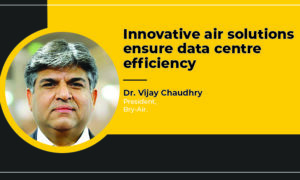Mr. Sushil Teotia, Asst. Vice President at Bry-Air, emphasises the company’s commitment to clean, green energy and reducing CO2 emissions for a more sustainable world. He explains that the company is working on incorporating sensors and decision-making technology into their machines, which will help to design smarter machines for the Industry.
How do they aim to contribute to creating a more sustainable world?
Our portfolio consists of the customer-oriented offerings of the Pahwa group, comprising Bry Air, DRI, Delair and TDS. Our foremost priority is energy efficiency, and we aspire to contribute to a greener and more sustainable world by promoting clean energy and devising measures to reduce the overall release of CO2 into the atmosphere. By encouraging customers to conserve energy, we can effectively reduce the CO2 emitted in generating that energy. As a group, we are thus focusing our efforts in this direction.
How do your products cater to the specific needs of data center businesses?
We are targeting the data center market in our upcoming ventures, where reliability is paramount. Maintaining the appropriate atmosphere is crucial to ensure data security across all facilities. To cater to this industry, we have two distinct products – a dehumidifier that regulates temperature and humidity and equipment for gas phase filtration that eliminates harmful fumes like SOx and NOx. Our main goal is to support our clients and prevent unforeseen system failures or breakdowns that may cause them to breach their contracts with end consumers.

How do you ensure energy efficiency in your production?
Last year, we introduced P95x to the pharmaceutical industry. Dehumidifier regeneration cycle, which requires significant energy usage, is critical. Typically, an industrial dehumidifier requires a temperature of 140 degree C to regenerate the entire system. However, we have developed a new generation Rotor that can be regenerate at 95 degrees, resulting in a >30 percent reduction in energy consumption.
What kinds of innovations are happening, especially looking at the energy future?
We invest significant time and effort in research and development. Our scientists are conducting material-level R&D at our internal facilities, having world-class infrastructure. This enables us to discover novel materials that offer equivalent performance while using less energy. Our focus on R&D has made these breakthroughs possible.
We recently launched our innovative smart series, which utilises IoT technology to sense the load in incoming air and make decisions based on embedded AI. This series determines the appropriate amount of electrical or steam load required to balance the process air moisture load and deliver optimal conditions within an Application area or at a controlled environment. By combining sensors and decision-making capabilities with metallurgy, we are creating smart machines that meet the needs of our customers. Integrating multiple aspects enables us to design more efficient and effective machines.
How are you committed to achieving a better carbon footprint?
We are committed to meet the evolving demands of our clients and are actively working on developing new systems and technologies to support these efforts. Our current focus includes several projects in the development stage and the latest breakthrough is the water generator that produces water from the air using adsorption technology. This machine is particularly useful in areas with limited access to water. We are exploring the potential of this technology for a range of applications, from providing drinking water for small consumption, laboratories to larger requirements such as hotels, commercial installations and to meet industry requirements. We believe this innovation can revolutionise the industry, making it possible to simply install a machine and produce water from the atmospheric air.
Looking at it from the commercial perspective, how do you see the need for cooling growing in India?
India is growing, especially, post COVID-19, awareness has grown across all industries. Many clients are now maintaining low RH, the government and regulatory agencies have tightened many regulations, whereas earlier, they weren’t doing so As a result, the cooling industry will undoubtedly experience a rise in demand. Dehumidifiers, in particular, will unquestionably play a significant part in fulfilling that requirement.
By observing the current industry trends, I sense a growth rate of over 30 percent. It will primarily come from organic growth resulting from current installations/ setups and from new investment opportunities. This increase in demand is driving through numerous new projects and investments. In particular, the cooling industry will experience significant growth, as evidenced by the construction of many glass skyscrapers in Indian cities that require substantial cooling loads. As a result, this industry will likely be in high demand.
How do you envision this contributing to a more eco-friendly future?
We are actively seeking ways to reduce the energy consumption of our machines. One approach we are exploring is the development of new materials and methods to lower the reactivation temperature. By reducing the electrical load on our machines, we can also reduce the load on associated utilities that are connected to them, resulting in a cascading effect that decreases the cooling/heating demand for all attached utilities. We focus on improving machine efficiency and lowering energy consumption, ultimately contributing to a more eco-friendly future.
Cookie Consent
We use cookies to personalize your experience. By continuing to visit this website you agree to our Terms & Conditions, Privacy Policy and Cookie Policy.















